BEST Marinara Sauce
This post may contain affiliate links. See my disclosure policy.
Look no further for the BEST Marinara Sauce recipe EVER! You won’t find a more flavorful marinara sauce. It’s easy to make and is absolutely PACKED with flavor! Canning instructions are included so you can enjoy the fresh flavor of tomatoes all year long!

What is Marinara Sauce?
Marinara sauce is a popular tomato sauce that is an essential staple in Italian cuisine. It consists of tomatoes, garlic, onions, olive oil, and a variety of herbs and spices. It’s known for its bright and fresh flavor, is highly versatile, and is a key component in many Italian dishes such as chicken parmesan, eggplant parmesan, pasta alla norma, and spaghetti and meatballs.
Ingredients
It’s hard to beat a simple dish of fresh pasta topped with homemade marinara sauce. The key is using quality products and when you have those these simplest of dishes come to life. The Italians have relied on the best of the best tomatoes for centuries: Sun-kissed San Marzano tomatoes. They’re stronger in flavor and much sweeter than most any other variety. And for that reason it’s hard to replicate the flavor of the marinara sauces you find in southern Italy. Our tomatoes require the help of a few flavor boosts, a dash of sugar being one of them.
This marinara sauce is slow-simmered with a variety of herbs and seasonings for 2 hours. The end result is a delicious sauce you can either eat right away, freeze or can for long-term storage so you can enjoy the vibrancy of Summer all year long! This is the BEST marinara sauce for canning!
I am often asked if you can use fresh onions instead of dehydrated onions. I recommend dehydrated onions for two reasons 1) fresh onions are high in water and can dilute and interfere with the pH level of the tomato sauce (this is not important however if you are not canning the sauce and 2) dehydrated onions are especially suited to canning because their flavor is more concentrated and they contribute a better flavor long-term.
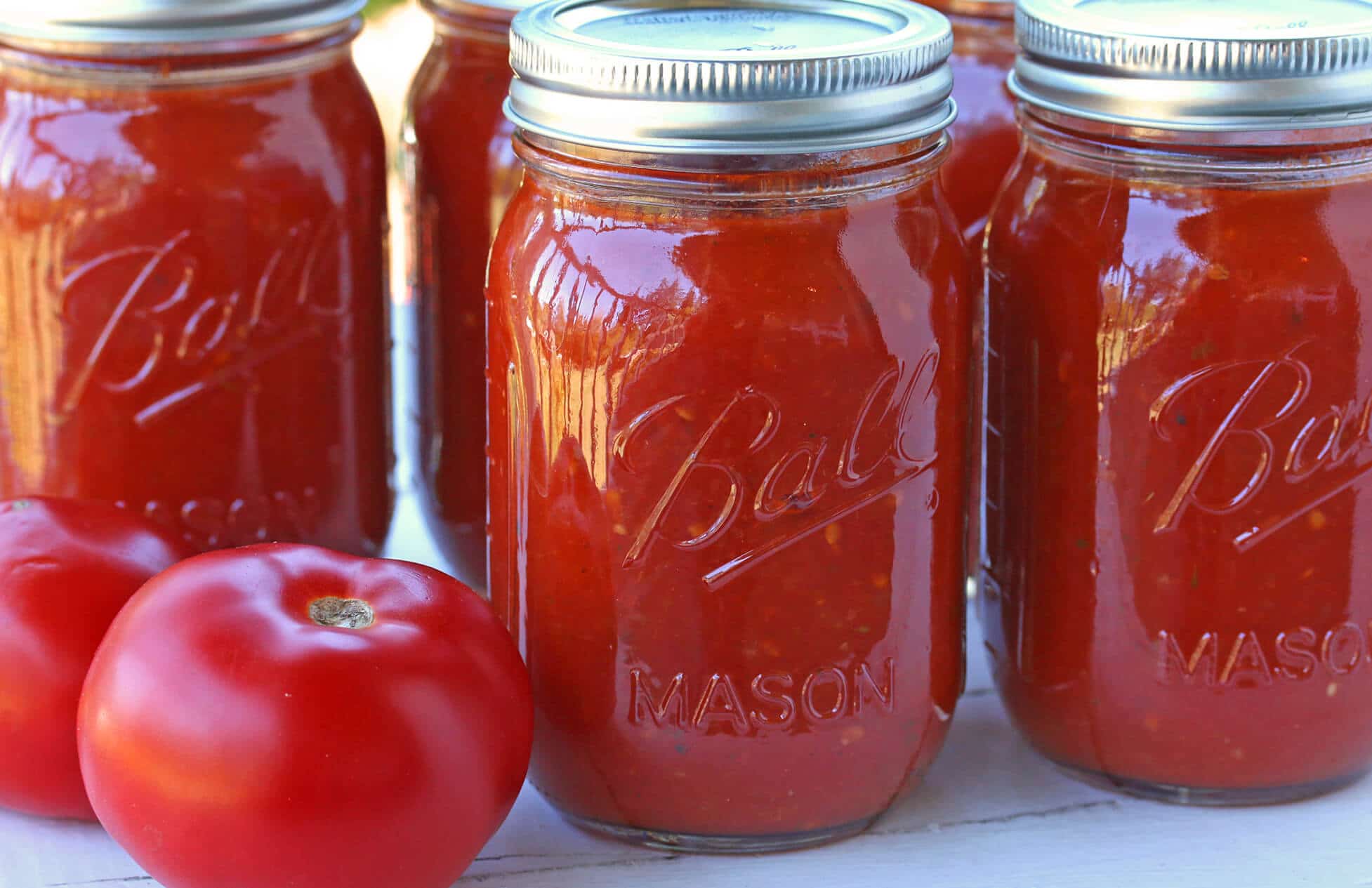
Can You Freeze Marinara Sauce?
Yes, this marinara freezes really well and there is no need to add lemon juice or citric acid. Put the cooled marinara sauce in freezer ziplock bags and lay them flat to take up less space or freeze the sauce in containers. It will keep for up to 6 months. Simply thaw and reheat on the stovetop or in the microwave.
Marinara Sauce Recipe
Select the best tomatoes you can find. The ideal tomatoes are ones that are very meaty with few seeds. Roma tomatoes fall into that category and are the most readily available and they, like other paste tomatoes like San Marzano’s, develop the best flavor when cooked down into a sauce. That said, you can use whatever tomatoes you have available and if they’re grown in your own garden so much the better.
Blanch the tomatoes for a minute in boiling water to loosen the skins. Peel the tomatoes and squeeze out and discard the seeds. Chop the tomatoes.
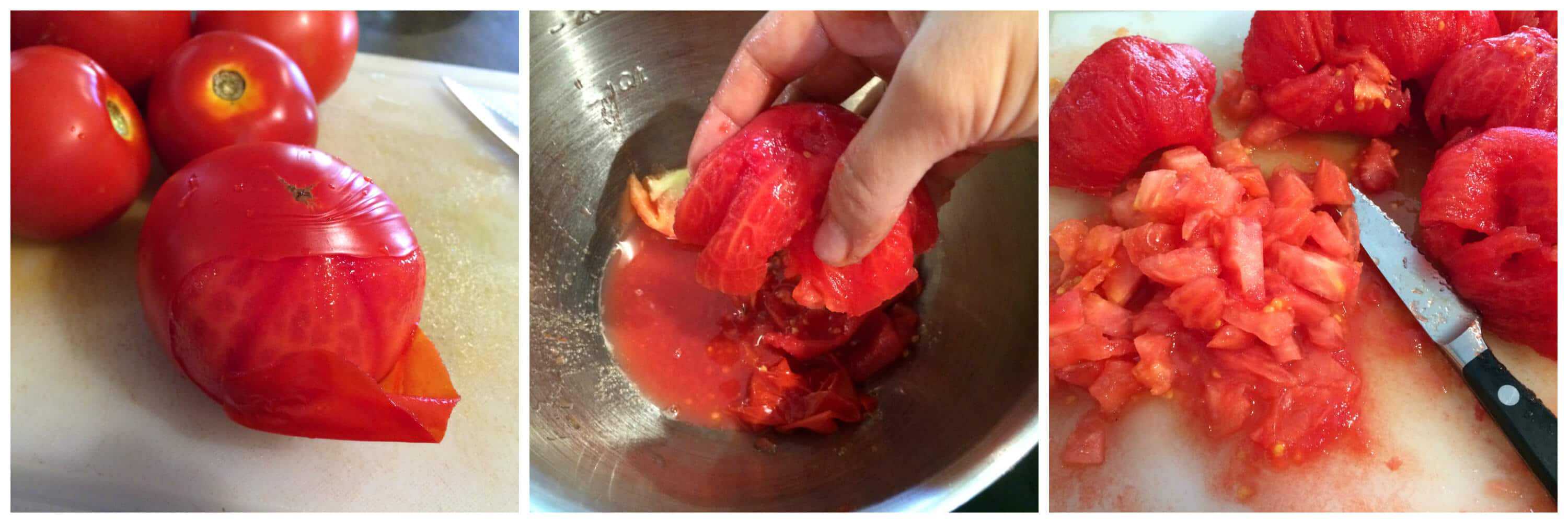
Place the tomatoes in a large pot with all the ingredients (except for the citric acid/lemon juice). Bring it to a boil, reduce the heat to low and simmer, uncovered, for 2 hours, stirring every once in a while. Adjust seasonings to taste. Discard the bay leaves.

Use an immersion blender or transfer to a blender and puree until desired consistency.
I use and recommend Cuisinart’s Immersion Blender, I’ve been using mine for 10 years and it’s still going strong.
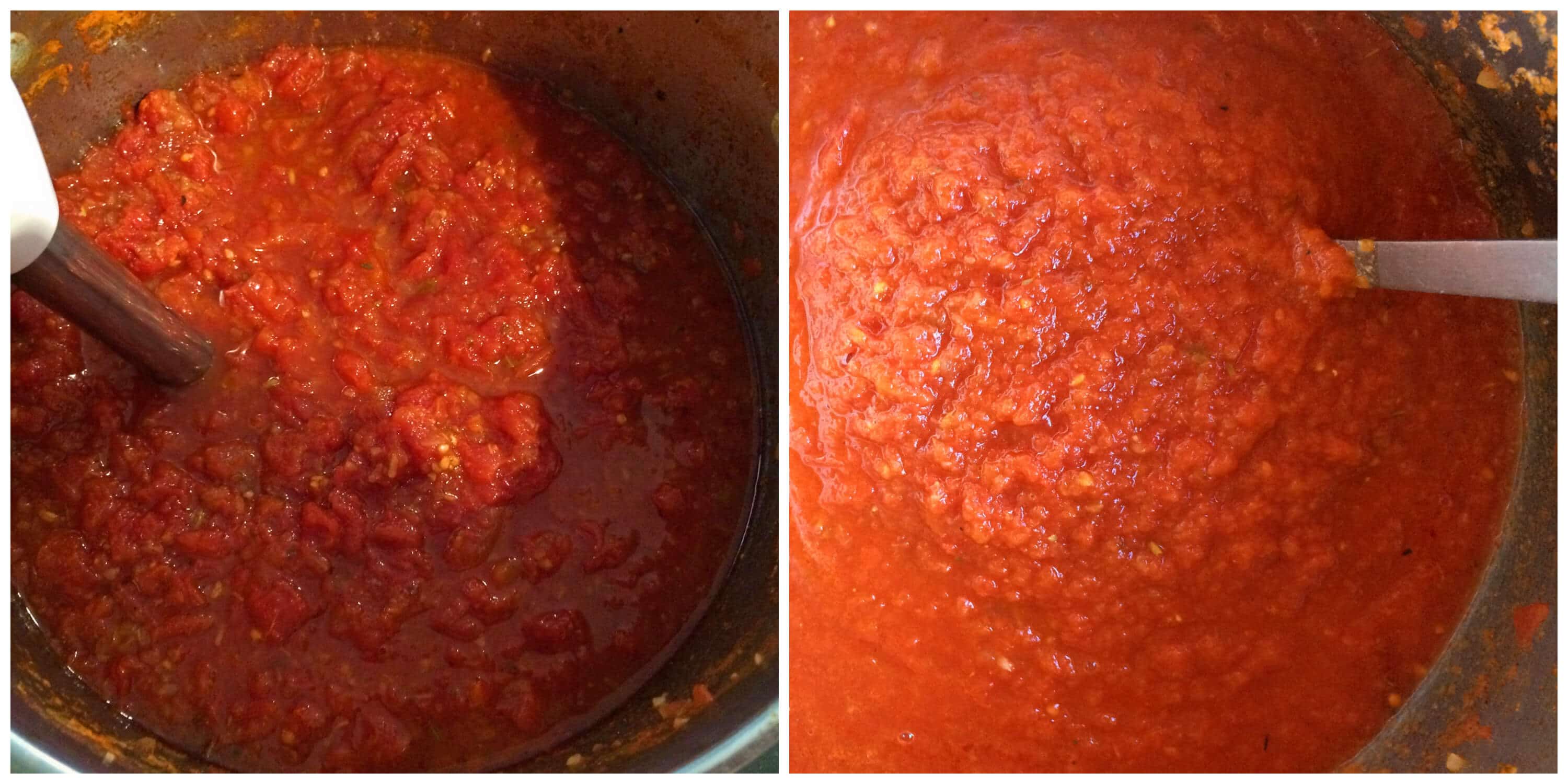
The sauce is ready but the flavor is even better after a day or two.
You can either enjoy the sauce now, freeze it, or can it for future use.

How to Can Marinara Sauce
Before you fill the sterilized jars with the marinara sauce, add 1/4 tsp Citric Acid per pint or add 1 tbsp bottled lemon juice per pint (double those quantities for quarts). This is per USDA guidelines as a requirement for safe canning. Fill the hot marinara sauce into the jars leaving 1/2 inch headspace. Wipe the rims of the jars with a damp cloth. Screw on the clean lids and rims.
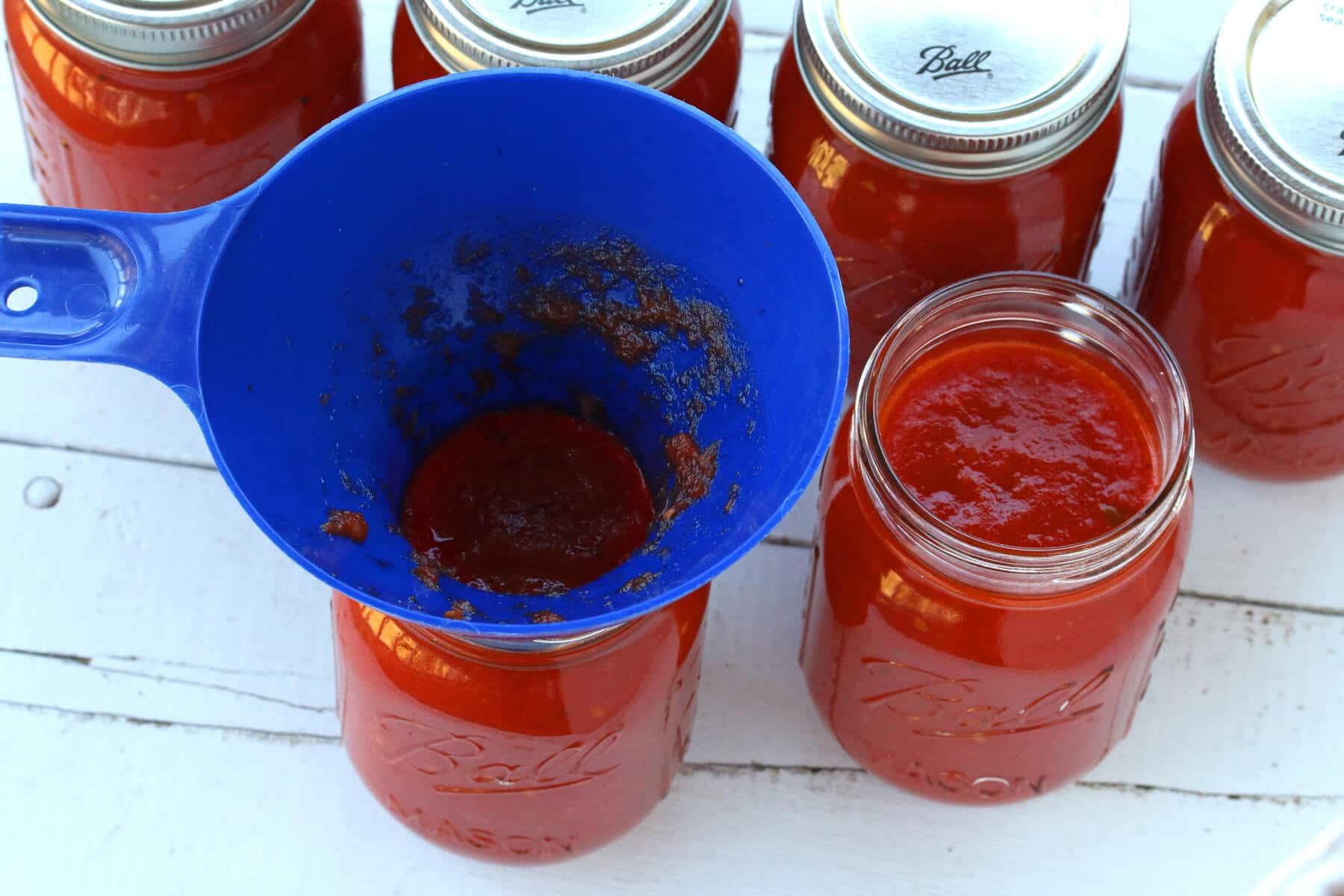
Next you’ll use a water canner to process the jars. This complete canning set has everything you’ll need. Place the jars in the boiling water canning and process for 35 minutes for pints and 40 minutes for quarts (wait for the water to return to a boil before you start the time). Turn off the heat and let the jars rest for 5 minutes before removing.
Adjustments for canning at high altitude:
- At 1,001 to 3,000 feet (305 to 914 meters) above sea level: increase processing time by 5 minutes.
- At 3,001 to 6,000 feet (914 to 1,829 meters) above sea level: increase processing time by 10 minutes.
- Above 6,000 feet (1,829 meters) increase processing time by 15 minutes.
Carefully remove the jars from the water canner and let them sit undisturbed for 24 hours. Check the seals. Stored in a dark, cool place the jars will keep for at least a year but for best flavor use within six months.

Enjoy!

For more fabulous canning recipes be sure to try our:
- Pickled Pepperoncini Peppers
- Pickled Jalapenos
- Pickled Okra
- Dill Pickle Relish
- Giardiniera
- Corn Relish
- Bread and Butter Pickles
- Sweet Pepper and Onion Relish
- Pickled Onions
- Pickled Carrots
- Pickled Banana Peppers
- Pickled Green Beans
- Pickled Asparagus
- Pickled Beets
Save This Recipe
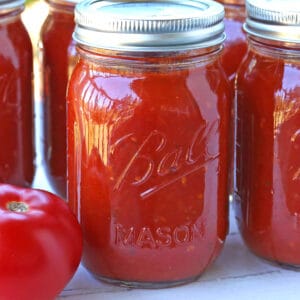
BEST Marinara Sauce
Ingredients
- 12 pounds ripe tomatoes
- 1/2 cup dried/dehydrated minced onion (provides a great flavor boost and is especially suited to canning for long-term storage)
- 6 cloves garlic, minced
- 1/4 cup extra virgin olive oil * omit if canning (see note)
- 3 tablespoons brown sugar
- 2 tablespoons sea salt
- 1 tablespoon dark balsamic vinegar
- 1 1/2 teaspoons dried rosemary
- 1 1/2 teaspoons dried oregano
- 1 1/2 teaspoons dried basil
- 1 1/2 teaspoons dried thyme
- 1 teaspoon crushed fennel seeds
- 1/2 teaspoon dried ground sage
- 1/2 teaspoon freshly ground black pepper
- 2 bay leaves
- citric acid or bottled lemon juice, if canning (per USDA guidelines as a requirement for safe canning)
Instructions
- Blanch the tomatoes for about a minute in a pot of boiling water to loosen the skins. Peel the tomatoes, squeeze out and discard the seeds. Chop the tomatoes.
- Place the chopped tomatoes in a large pot along with the remaining ingredients (except for the citric acid). Bring to a boil, reduce the heat to low and simmer, uncovered for 2 hours, stirring every now and then. Discard the bay leaves. Adjust the salt and pepper to taste. Use an immersion blender or transfer to a blender to puree until desired consistency is reached.You can use the sauce now (flavor gets better in a day or two), freeze it or can it for long-term storage.
- To can the sauce: Place 1/4 teaspoon citric acid or 1 tablespoon bottled lemon juice in the bottom of each sterilized pint-sized jar (double the quantity for quart jars). Ladle the hot marinara sauce into the jars, leaving 1/2 inch headspace. Wipe the rims clean with a damp cloth. Screw on the clean lids and rims. Place the jars in a boiling water canner and process 35 minutes for pints and 40 minutes for quarts. Turn off the heat and let the jars sit for 5 minutes. Remove the jars and let sit undisturbed for 24 hours. Check the seals. Stored in a dark, cool place the jars will keep for at least a year but for best flavor use within six months.Makes approximately 6 pints.
Notes
- At 1,001 to 3,000 feet (305 to 914 meters) above sea level: increase processing time by 5 minutes.
- At 3,001 to 6,000 feet (914 to 1,829 meters) above sea level: increase processing time by 10 minutes.
- Above 6,000 feet (1,829 meters) increase processing time by 15 minutes.
Nutrition
Originally published on The Daring Gourmet September 8, 2017



















Hi Kimberley,
Is it ok to use fresh herbs in this recipe or are dried used for a reason? If fresh is ok, what quantity would you recommend please?
Hi Karen, dried herbs often used for dishes that are simmered for a long time because the long cooking process coaxes the oils/flavors out of them and leaves them soft. For those who don’t grow their own herbs, dried herbs are much cheaper. But you can definitely use fresh herbs instead and generally you’ll use 3 times the amount in fresh herbs that you would use for dried (so instead of one teaspoon dried you would use three teaspoons fresh).
Thank you, much appreciated. I’ll definitely give fresh herbs a go
I’ve never done this before, but I gave it a shot! I had well over a peck but under two pecks of tomatoes and I produced 4 quart jars and 3 pint jars. I couldnt decide whether to puree or not. I pureed two quarts and the sauce turned paler, so the next quart I only pureed half the jar. The fourth quart I didn’t puree at all, I will label that jar spaghetti sauce instead of marinara. The 3 pints I went back to pureeing half the liquid. We’ll see.. It looks thinner than regular spaghetti or marinara sauce to me, so I’m nervous I did it wrong! I let it simmer A LOT with the lid off, maybe 3 hours instead of two hoping it would thicken up which it did a bit but I’m still nervous! Also, I forgot the lemon juice in all the chaos for the 4 quart jars, I’ll just have to use those quicker than normal and hope there was enough acid in the tomato varieties I used! I remembered it for the 3 pint jars though.
Hi Kris, depending on the variety of tomatoes you’re using it may very well take longer to thicken (some varieties have much more water than others). And yes, since there’s no lemon juice in them you’ll either want to freeze the sauce or keep it refrigerated and use it within a week.
Making this now. The only difference is I used two 6lb cans of tomatos. Hopefully it turns out ok.
Awesome, let us know how it turns out! I’m getting ready to make another batch for canning – it’s so rewarding being able to reach for a jar of ready-made homemade marinara.
This sauce looks amazing! Can it be done in the slow cooker?
If yes, how much time do you recommend?
Thanks, Alejandra. Yes, this should work really well in the slow cooker – place all the ingredients in the slow cooker (except for the citric acid or lemon juice) and I’d aim for around 2-3 hours on HIGH or 3-4 hours on LOW (you’ll just need to check it to see when it’s thick enough). And leave the lid off so the sauce can evaporate and thicken.
This looks very interesting. How did you calculate your nutritional breakdown and is it accurate? I do find the sugar count high for only 3 tbsp of sugar.
Hi Gare, the software populates the nutrition info automatically. This recipe makes 6 pints and this case the one serving in the nutrition box is referring to one pint.
i make it quite often. made it the other day without peeling the tomatoes before cooking, and while boiling, the peel seperates from the “flesh” and can be lifted with a fork. i add garlik, and yes, can be made without sugar. by the way, uf short of fresh tomatoes, canned, peeles and crashed tomatoes (800 grams can) can be used. enjed your recipe. thank u.
Thanks for feedback, Zohar, and I’m glad you enjoyed it!
I’ve been making marinara sauce for over 50 years and often try new recipes as I see them either in cook books or online. This is undoubtedly the worst recipe for marinara sauce I’ve ever seen.
You haven’t even tried this recipe, Frank, what are basing that conclusion on?
The list of ingredients — rosemary, sage, thyme, citric acid, brown sugar! In a marinara sauce?
This very well may be a good ‘some type of sauce, but is a very long way from being called a marinara sauce.
Frank, here is the definition of marinara sauce: “Marinara sauce is an Italian tomato sauce that originated in Naples, usually made with tomatoes, garlic, herbs, and onions.” Rosemary, sage and thyme are Italian herbs. Not sure what you find so alarming about that.
As for the brown sugar, I explain that in the post – today’s tomato varieties leave a lot to be desired and are far less sweet than they used to be. The sugar, a very common addition now to tomato sauces, helps remedy that.
The citric acid: You’ll note from the title that this recipe includes instructions for canning and the citric acid (or lemon juice) is a requirement to get the pH level below 4.6 for safe canning.
Can this be made without the sugar?
Hi Kathryn, the sugar is added for flavor not for canning safety. The sugar helps compensate for today’s tomato varieties lacking the sweetness they used to and it makes a significant difference in the flavor of the sauce. Keep in mind too that it’s only 3 tablespoons divided between 6 pints. But yes, it can be omitted.